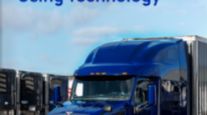Fleets Focus on Emissions, SmartWay’s Bynum Says
This story appears in the Oct. 24 print edition of Transport Topics. Click here to subscribe today.
GRAPEVINE, Texas — The new federal rule designed to reduce truck greenhouse-gas emissions by 10% or more starting in 2014 effectively is forcing manufacturers to focus on selling advanced pollution-reduction equipment to fleets that today don’t have the technology such as auxiliary power units, a government official said.
That was a key message from Cheryl Bynum, director of the Environmental Protection Agency’s SmartWay program to attendees at American Trucking Associations’ Management Conference and Exposition here.
Her agency and the National Highway Traffic Safety Administration last year set the first-ever standard for cutting emissions of carbon dioxide from engines and tractors. The standards take effect in the 2014 model year, with stricter emissions standards to become effective starting in 2017.
“We expect [manufacturers] to use pretty much for what they are doing for most sophisticated fleets today,” she said. “We want to increase the use of existing technologies, those that are currently on the shelf and for some reason not applied” by some carriers, she said on Oct. 16.
The new rule continued to generate questions from industry officials.
For example, Old Dominion Freight Line President David Condon asked Bynum whether truckers such as his company, which already have made wide use of emissions reduction equipment, faced a mandate to do still more.
“There are a lot of trucks that are operated by leading fleets,” Bynum said. “Many people aren’t optimizing this technology. In some cases, fleets don’t believe the technology will work, and other fleets can’t afford to test it.”
Bynum also said, in response to another question, that the need for manufacturers to meet the emissions standards could be a bargaining chip for fleets when they are discussing prices and specifications with suppliers.
She said she believed federal funds still were available from federal diesel emissions and economic stimulus programs to help carriers pay for trucks with lower emissions. Congress hasn’t yet authorized any future funding.
She also was asked whether fleets that bought equipment such as speed limiters to lower fuel use and cut emissions would wind up being hurt because drivers who didn’t like them would go to work somewhere else.
Bynum answered that EPA and NHTSA don’t regulate vehicle speed.
Among the approaches that manufacturers could use would be achieving compliance on an average basis, instead of on every engine and tractor. “We have a lot of flexibility in the rule,” Bynum said.
In addition, she said, compliance standards can be met by achieving emissions reductions in advance and applying them after the rule takes effect. Some of those benefits, such as speed limiters or single-wide tires, could be achieved as early as 2013, she added.
The joint rulemaking standard was designed to make compliance easier for fleets and their suppliers, which would have to meet only one set of standards instead of two if the agencies were working separately, she said.
The agencies decided not to propose emissions-reducing standards for trailers, she said, because there are so many varied sizes, configurations and specifications of trailers. There is no date when the agencies plan to write a new rule for trailers, and no deadline by which they have to do so.
There are three broad vehicle categories covered by the rule, she said, including line-haul, heavy-duty pickup trucks and vans and vocational trucks, a broad category covering package delivery trucks, ambulances, construction industry trucks and waste vehicles.
Savings are achievable in the vocational truck category because those vehicles already are making broader use of alternative fuel vehicles, Bynum said.
Another positive point she offered was fast payback to fleets. The estimated cost on average to meet the new standard is $6,220, and that could be offset within a single year in the form of fuel expense reductions, she said.
“In phase 2 [after 2017] they will go after more aggressive technology, such as waste-heat recovery,” said Bynum, referring to manufacturers.
“We really wanted to meet the president’s directive to us to make this work for the market,” she said, noting what she called “an enormous amount of stakeholder outreach” to carriers and manufacturers through public hearings and meetings. More than 5,000 comments were received during the rulemaking, nearly all of them positive, she said.




